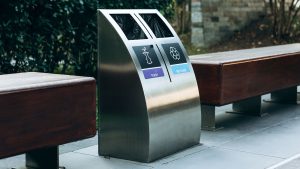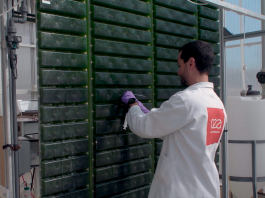Upgrading to smart waste management systems can create cleaner, greener and more spacious urban environments.
Smart cities represent the integration of technology into the traditional infrastructure of our urban environments. One of the key areas where this integration is making a significant impact is waste management. Smart city waste management leverages technology to enhance the efficiency of waste collection, transportation, and disposal, while minimising the environmental impact.
Envac recognises the value of smart and efficient waste management, establishing smart waste schemes across the globe. Its innovative approach has seen considerable success, moving waste out of sight and mind of the public, before managing and utilising it sustainably.
The Innovation Platform spoke with Kent Norlenius, CTO of Envac to discuss the importance of smart waste technologies, the benefits that come with removing waste from street level, and what needs to be done to roll out the system on a larger scale.
Can you summarise Envac’s smart city waste management system, the technologies used and the key areas the system targets?
Envac is delivering infrastructure for the city. Waste is more or less the only infrastructure that remains on street level, with everything else moving below the surface long ago. The aim now, is to move waste infrastructure underground, thus removing traffic, simplifying the system for the users, and creating more space.
More recently, we have focused on the addition of digital infrastructure; developing communication with our users, becoming a source of education, and providing feedback on how their behaviour could be improved to protect the environment.
For users, this will bring noticeable differences: You will see fewer trucks; it is easier to get rid of your waste and recyclables; it is immediately available; and no walking around the area searching for recycling bins is necessary. The smart waste management system targets convenience and aims to improve the surroundings.
Essentially, we are modernising the waste management system, bringing it up to date with other areas of infrastructure – e.g., sewage, water, central heating, gas.
Why is it important to develop these advanced waste management systems?
Cities are becoming increasingly dense, and growing populations require more infrastructure and recreational spaces. It is not sustainable – logistically and environmentally – to add more bins and trucks to the area to meet this demand. To maximise our use of the space, we need to adopt a different approach. Our solution is underground pipes; an efficient and hidden system that frees the area above for alternative uses.

Moreover, the method of co-ordinating different coloured bags for different waste fractions enables a greater degree of control over the entire system. The types of waste disposed of can be monitored and controlled, and by installing it below street level, any waste disposed of that could pose a risk to the population is well removed.
Such a system is also considerably easier to scale up to meet demand. Smart waste management systems can simply be upgraded with additional inlet points. There is no requirement for additional trucks or bins, nor any more driveways. By moving waste underground, it is possible to declutter the city in a multitude of ways.
Envac has several smart city projects already underway, can you elaborate on some of these?
The definition of a smart city system varies around the world; with projects around the world, each requiring specific needs to be met, it is a smart city ecosystem. In Tianjin, China, the focus is to simplify the city for users and to reduce traffic. This is part of a wider aim to create sustainable, resource efficient communities.
Old, historic cities like Bergen, with its wooden buildings have focused on protecting the city from fire, and a huge part of this is waste-related fires. Alongside that, the project aims to modernise the traditional city and increase space in a city with incredibly narrow streets.
Similarly, in Stockholm, Sweden, the last 20-30 years have been dedicated to transforming the rundown industrial area into a popular, attractive residential area. Hammarby Sjöstad is now home to the latest in smart and sustainable technologies, designed to meet rigorous sustainability targets.
Some of the most advanced examples of a smart city are in Singapore and in Korea. One of the largest projects Envac is involved in is the city of Sejong in Korea. With a population predicted to grow from 30,000 to 500,000 by 2030, the city aimed to maximise space, and has implemented digital systems within its infrastructure.
The Envac system has been operating in Sejong since 2015, becoming an integral part of the city’s infrastructure and has minimised the waste collection vehicles on the road as well as reducing the operating costs for waste management across the city.
The Jin Sha Zhou eco-town is the first residential community in mainland China to use the system comprehensively. The town has seen the benefits, with space once used for waste transfer now transformed into space for new residential buildings.
Furthermore, the system has simplified the work of the local cleaning force, since waste from high-rise buildings is now all collected in one place, as opposed to requiring collection on each floor.
Can you discuss the ways in which Envac’s system facilitates sustainable practices and enhances quality of life?
Regarding sustainability, it is as simple as less traffic, less local pollution. By streamlining and redistributing the work involved in waste management, smart waste management systems make the process more efficient.
Not only does it reduce the numbers of trucks on the roads, but also the frequency with which they would be needed. Through the digitisation of bins and using sensors to take measurements and statistics, we can achieve a constantly evolving, optimised, and real-time understanding of what is necessary.

For example, five bins are placed on a street and after six months, the data indicates only three are being frequently used, we can reduce the frequency with which the waste is collected and be more energy efficient.
Furthermore, the system contributed towards resource circularity by collecting, sorting, and reusing waste. The colour-coordinated bags are all deposited into the same waste inlet, reducing the pressure on the end user. The waste then deposited is sorted and can be recycled or transformed into energy sources – e.g., food waste can be converted to biogas and fertiliser.
The system recognises the importance of involving and interact with the residents to ensure that the system delivers what the population wants, thus the objective is to ensure that increasingly dense cities do not result in decreasing quality of life.
With waste transported outside of the city underground before collection, fewer trucks roam the roads, decreasing congestion and improving road safety for children and pedestrians in general. The space saved by removing waste management from street level can be used to expand or create new green areas.
Equally, an underground system will reduce the numbers of vermin around, as well as tackling unpleasant odours. Smart infrastructure such as this results in a safer, and more hygienic, environment, developed and maintained with sustainable practices in mind.
Can we expect to see smart city waste management rolled out more widely?
The smart city is a product of modern technology and modern requirements. Cities not only have to cater for a large population but must adopt more sustainable approaches and establish circular economies to maximise resources. Upgrades to our cities therefore need to be comprehensive, which means upgrading our infrastructure to facilitate the objectives above.
Global trends are indicating large migration into cities, and combined with a steadily increasing population, spaces are becoming more densely populated. Essentially, waste management in cities is a problem that is only going to grow.
Now, developers and governments alike are starting to see the associated costs of increasingly clogged up streets. This is what will ultimately see smart waste management systems implemented on a larger scale, as the costs of adding to existing waste management start to outweigh those of installing smart systems.
Bins are not expensive to buy, whereas systems like ours are more expensive initially. This is the key point; smart waste management systems are the most cost-effective and efficient choice long-term. Developers and authorities are coming to this conclusion, but it will take continued efforts to raise awareness to see these systems rolled out more widely.
This is the main challenge faced in implementing this solution on a large-scale. Significant, upfront investment is required before any benefits can be seen. By showcasing success stories and highlighting those benefits to quality of life, it is becoming easier to convince governments that this is, indeed, a worthwhile investment.
Please note, this article will also appear in the sixteenth edition of our quarterly publication.





